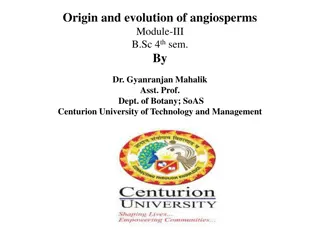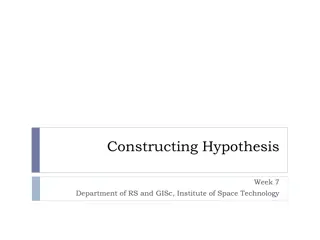Hypotheses on the Origin of Earth and Earth's Formation
Various materialist hypotheses proposed by scientists such as Kant, Laplace, Schmidt, and Fesenkov regarding the origin of Earth and the solar system. These hypotheses suggest different processes, including the formation from primary dusty matter, hot nebula, interstellar meteorite dust, and gas-dust nebula accumulation. Kant-Laplace hypothesis combining warming and cooling stages, while modern views challenge these ideas based on the discovery of hot gas nebulae. The Earth's internal energy source is attributed to radioactive decay and chemical reactions.
Download Presentation

Please find below an Image/Link to download the presentation.
The content on the website is provided AS IS for your information and personal use only. It may not be sold, licensed, or shared on other websites without obtaining consent from the author.If you encounter any issues during the download, it is possible that the publisher has removed the file from their server.
You are allowed to download the files provided on this website for personal or commercial use, subject to the condition that they are used lawfully. All files are the property of their respective owners.
The content on the website is provided AS IS for your information and personal use only. It may not be sold, licensed, or shared on other websites without obtaining consent from the author.
E N D
Presentation Transcript
1. Materialist hypotheses of the origin of the Earth. 2. Form, structure and physical properties of the Earth. 3. Earth's crust, its structure and physical properties. 4. Thermal features of the Earth.
Literature: 1. Zaritsky P.V., Tikhonenko D.G., Gorin M.O., Andreev V.V., Degtyarev V.V. Geology with the basics of mineralogy: a textbook, ed. P.V. Zaritsky, D.G. Tikhonenko. Kharkiv: Maidan, 2012. S. 35 45. 2. Kanivets V.I., Parkhomenko M.M. General and Quaternary geology and geomorphology: a textbook. Chernihiv: Desna polygraph, 2015. P. 7 10; 12 15. 3. Kratenko L. Ya. General Geology: Textbook, 2nd ed. Dnipropetrovsk: NMU, 2008. S. 21 56. 4. Tikhonenko D..G., Degtyarev V.V., Shchukovsky M. A., Yazykova A. G. and others. Geology with the basics of mineralogy: a textbook, ed. D. G. Tikhonenko. Kyiv: Higher Education, 2003. P. 9 22. 5. Bilenko D. K. Fundamentals of geology and mineralogy. Kyiv: Higher School, 1973. P. 14 35. 6. Tolstoy M. P. Geology with the basics of mineralogy. Moscow: Higher school. 1991. S. 7 32. 7. Gursky B. N., Gursky G. V. Geology. Minsk: Higher school. 1985. S.18 27. 8. Gnatenko O. F., Kapshtyk M. V., Petrenko L. R., Vitvitsky S.V. Soil science with the basics of geology: a textbook. Kyiv: Oranta, 2005. S. 17 22.
1. Materialist hypotheses of the origin of the Earth. The first scientific hypothesis about the origin of the solar system belongs to the German philosopher I. Kant, which he proposed in 1755. According to I. Kant's hypothesis, the Earth and other planets of the solar system were formed from primary dusty matter, which was in chaotic motion. According to the law of gravity, these different sized particles began to move. Heterogeneous star clusters formed, which, in turn, began to attract smaller ones. Thus, separate large clusters were formed, which became separate stars. According to the hypothesis of the French mathematician and astronomer Pierre-Simon Laplace (1796), the planets were formed from sparse matter, from a hot nebula in the center of which the Sun arose. Cooling and compaction led to an increase in the speed of rotation and separation from the nebula of a series of rings that rotated constantly, on which later formed planets.
According to both Kant and Laplace, the Earth, like other planets, underwent a warming stage during compaction and subsequent cooling, so this hypothesis is often combined into one Kant-Laplace. In the early twentieth century. these hypotheses have ceased to satisfy scientists because science has not discovered hot gas nebulae in the universe. They were changed by the ideas of Multon, Chamberlain, Jeans and Jeffries about the collision of the Sun with other cosmic bodies, but according to modern views, the probability of such a collision is extremely small.
According to O. Schmidt's hypothesis (1944), the Earth and other planets of the solar system were formed from interstellar meteorite dust, which was captured by the Sun as it passed through it. According to this hypothesis, the Earth originated as a cold body, and the source of its internal energy - the processes of radioactive decay of elements and various chemical reactions. Academician V.G. Fesenkov (1960) believed that the Sun and planets were formed due to the accumulation of gas-dust nebula. Given that the age of the Sun is very close to the age of the Earth, he assumed that the Sun and the planets formed simultaneously. In the distant past, several billion years ago, the Sun emerged, like other stars, from local condensation in a gas-dust environment that was in constant motion. Continuing to form in the star and intensively decreasing, the Sun had to reduce a significant amount of matter approximately in the equatorial plane, which due to very rapid rotation could not concentrate in a single body. Other planets were formed from such a gas-dust mass.
The latest enetic unity of the material composition of the entire solar system. The Earth, taking shape as a separate planet, began to warm up (due to radioactive decay (first Pu 244, Cm 248, and later U 235, U 238, Th 232, K 40)). This caused the melting of iron first, then silicates. Heavy liquid iron sank to the center of our planet and formed its core. From the silicate shell (mantle) as a result of zone melting formed the lithosphere, the oceans and the atmosphere, ie the earth's crust.
2. Form, structure and physical properties of the Earth. The size of the land is S = 510 million km2, m = 5.98 1021tons, V = 1083320 million km3, R = 6371 km, p = 5.52 g / cm3. The Earth is dominated by water - 361 million km2, land - 149 million km2(70.8 and 29.2 %). The earth has the shape of a geoid, which is slightly flattened from the poles, with an equatorial radius of 6378.2 km and polar - 6356.9 km, with differences in the earth's terrain of about 20 km (between oceanic depressions more than 11 km deep and the highest mountains above 8 km.) The structure of the Earth: internal (lithosphere, mantle, core) and external (atmosphere, hydrosphere, biosphere).
The lithosphere (Earth's crust) is a solid part of the mantle (900 km), which is called the Earth's rock shell. The lithosphere is divided into moving plates American, Eurasian, African. Indo-Australian, Antarctic, Pacific. The earth's crust consists of metamorphic rocks. The mantle - lies beneath the earth's crust and extends to a depth of 2900 km - to the Earth's core. Geophysical studies have established the heterogeneity of the structure and composition of the mantle, so it is divided into two parts - the upper and lower. Upper mantle: roughness 900 1000 km, composed of heavier rocks: peridotites, eclogites, dunites, ultrabasalts. Lower (roughness) is 1900 km. igneous, sedimentary and mantle: its thickness
The core - the central part of the Earth, starting from a depth of 2900 km is very dense. Up to a depth of 5120 km, the density is the same, and deeper - greatly increases, so it is divided into two parts: the outer core is at a depth of 2900 km. The substance is in a liquid state, more precisely in a state of plasma, increases the number of heavy elements, and quantitatively predominates iron, nickel, called Nife II (Nife II). The inner core at a depth of 5120 consists of iron, nickel, cobalt, chromium, copper, phosphorus, carbon, sulfur and possibly platinum, with about 90 % iron, 9 % nickel, and all other metals up to 1 %. Called the inner nucleus of Nife I (Nife I).
The atmosphere is the air envelope of the Earth, which is connected to it by gravity and participates in its diurnal and annual rotation. The boundary of the Earth's atmosphere is located at an altitude of up to 3000 km (at this altitude its density is equal to the density of interplanetary gas). The lower layer of the atmosphere adjacent to the lithosphere and hydrosphere is called the troposphere. In addition to the troposphere, the atmosphere includes the stratosphere (11 25 km), the mesosphere (25 80 km), the thermosphere (80 800 km), and the exosphere (more than 800 1000 km). Hydrosphere - a set of water on the Earth's surface and in the surface of the earth's crust (oceans, seas, rivers, lakes, swamps, springs, perennial glaciers of mountainous and polar countries). The biosphere is a zone of active life of organisms (plants, animals, humans) that inhabit the Earth and the entire space in which life is widespread. The biosphere includes the troposphere, hydrosphere and upper lithosphere.
3. Earth's crust, its structure and physical properties. The Earth's crust is the uppermost layer of the lithosphere, which is the product of physicochemical evolution of the upper mantle during geological time. The Earth's crust - the transformed lithosphere - is the product of the interaction of the lithosphere with the atmosphere, hydrosphere and biosphere on the one hand, and the mantle - on the other. There are three layers in the structure of the earth's crust: sedimentary, granite and basaltic. The sedimentary layer consists of soft and mostly loose rocks formed by the deposition of matter by water and wind, as well as glaciers on the Earth's surface. Sedimentary rocks have a layered structure, their density varies from 1 to 2.65 g /cm3. The thickness of the sedimentary layer varies from a few meters to 10-15 km. On the Earth's surface there are areas where the sedimentary layer is absent.
The granite layer is composed mainly of igneous and metamorphic rocks with an average silica content of more than 60 % and a density of 2.6 2.8 g /cm3. The thickness of the granite layer is different. Its greatest power (50-70 km) under modern mountain ranges (Pamirs, Alps). Under oceanic depressions, such as the bottom of the Atlantic and Indian Oceans, this layer is either completely absent or its thickness is insignificant. The basalt layer lies under the granite layer and has a thickness of 5 30 km. In terms of chemical composition and physical properties, the substance of this layer is close to basalts, ie to the main rocks, in which silica is contained much less than in granites. The density of the substance of the basalt layer increases to 3.32 g /cm3. The lower limit is considered to be the limit of the earth's crust, which is sometimes Mokhorovichich (the Yugoslav scientist who first established it). called the limit of
4. Thermal features of the Earth. Heat is of great importance in the life of our planet. The thermal regime of the Earth is due to two factors - the radiation of the Sun and the heat of the earth's interior. On the Earth's surface, the main source of heat is the Sun. Every minute 1 cm2of the Earth's surface receives about 8.13 J of heat (1.94 cal). The amount of solar heat is several thousand times greater than the heat that comes from the bowels of the Earth. Under the influence of solar heat, various processes take place: water cycle, weathering of rocks, soil formation and others. Thanks to solar energy, an organic world has emerged and is evolving.
The boundary of the distribution of zones of influence of external and depth factors of the thermal field is a layer of constant temperature, the depth of which in different regions of the planet varies considerably. Numerous studies in mines and wells have shown that below the constant temperature layer there is a natural increase in temperature with depth. However, the rate of change of this temperature in different regions of the Earth is not the same. This velocity is measured by the magnitude of the geothermal gradient, the essence of which is an increase in temperature by 10C with depth. The magnitude of this increase is small and is hundreds and thousands of degrees. Based on this, the geothermal gradient is mostly measured in0C per 100 m, which averages 3.30C. The second indicator that measures the rate of temperature rise with depth is the geothermal degree. The geothermal degree is the inverse of the geothermal gradient, the physical essence of which is the difference in depth, which corresponds to an increase in temperature by 10C. On average, it is assumed that the temperature rises by 10 C every 33 m.
Questions for self-preparation 1. Briefly describe the position of the Earth and the solar system in space. 2. What is the essence of the cosmological hypotheses of Kant, Laplace, Schmidt, Fesenkov? 3. Which planets belong to the terrestrial planets? 4.Give a general description of the planet Earth (shape, size, structure). 5. Name and describe the outer spheres of the Earth. 6. Name and describe the inner spheres of the Earth. 7. Earth's crust, its structure and physical properties. 8. What is called a geothermal degree and a geothermal gradient?





























